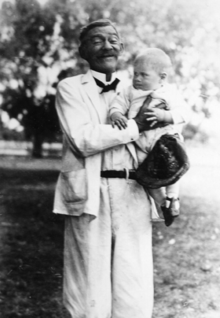G. B. Halsted

George Bruce Halsted (November 25, 1853 – March 16, 1922) was an American mathematician who explored foundations of geometry and introduced non-Euclidean geometry into the United States through his own work and his many important translations. Especially noteworthy were his translations and commentaries relating to non-Euclidean geometry, including works by Bolyai, Lobachevski, Saccheri, and Poincaré. He wrote an elementary geometry text, Rational Geometry, based on Hilbert's axioms, which was translated into French, German, and Japanese.
Life
Halsted was a tutor and instructor at Princeton University. He held a mathematical fellowship while a student at Princeton. Halsted was a fourth generation Princeton graduate, earning his Bachelor's degree in 1875 and his Master's in 1878. He went on to Johns Hopkins University where he was J. J. Sylvester's first student, receiving his Ph.D. in 1879. After graduation, Halsted served as an instructor in mathematics at Princeton until beginning his post at the University of Texas at Austin in 1884.
From 1884 to 1903, Halsted was a member of the University of Texas at Austin Department of Pure and Applied Mathematics, eventually becoming its chair. He taught mathematicians R. L. Moore and L. E. Dickson, among other students, who frequently joked that his primary criterion for the rationality of a geometric system was the simplicity of the terms in which it could express the closed space figure formed by the contours of his mustache. He explored the foundations of geometry and explored many alternatives to Euclid's development, culminating with his Rational Geometry. In the interest of hyperbolic geometry in 1891 he translated the work of Nicolai Lobachevsky on theory of parallels.[1] Halsted frequently contributed to the early American Mathematical Monthly. In one article[2] he championed the role of J. Bolyai in the development of non-Euclidean geometry and criticized C. F. Gauss.[3] See also the letter from Robert Gauss to Felix Klein on 3 September 1912.
In 1903, Halsted was fired from UT Austin after having published several articles that criticized the university for having passed over R. L. Moore, at that time a young and promising mathematician whom Halsted hoped to have as an assistant, for an instructor post in favor of a well-connected but less qualified candidate with roots in the area.[4] He completed his teaching career at St. John's College, Annapolis; Kenyon College, Gambier, Ohio (1903-1906); and the Colorado State Teachers College, Greeley (1906-1914).

Halsted was a member of the American Mathematical Society and served as vice president of the American Association for the Advancement of Science. Elected Fellow of the Royal Astronomical Society 1905 January 15 [Monthly Notices RAS v. 65 p. 185].
Publications
- Metrical geometry; An elementary treatise on mensuration (Boston, Ginn, 1890)
- The elements of geometry (New York, Wiley, 1889)
- Synthetic projective geometry (New York, Wiley, 1906)
- On the foundation and technic of arithmetic (Chicago, Open Court, 1912)
See also
References
- ↑ Nicholaus Lobatschewsky (1840) G.B. Halsted translator (1891) Geometrical Researches on the Theory of Parallels, link from Google Books
- ↑ Halsted, G. B. (1912). "Duncan M. Y. Sommerville". American Mathematical Monthly 19: 1–4. doi:10.2307/2973871.
- ↑ Sondow, J. (2014). "From the Monthly Over 100 Years Ago…". American Mathematical Monthly 121: 963. doi:10.4169/amer.math.monthly.121.10.963. arXiv "Gauss and the eccentric Halsted".
- ↑ John Parker, R.L. Moore: Mathematician and Teacher, Mathematical Association of America, Washington, DC, 2005, ISBN 0-88385-550-X, 2005, pp. 36-37.
- "George Bruce Halsted", J J O'Connor and E F Robertson, School of Mathematics and Statistics, University of St Andrews, Scotland.
External links
- Works by George Bruce Halsted at Project Gutenberg
- Works by or about G. B. Halsted at Internet Archive
- G. B. Halsted at the Mathematics Genealogy Project
|